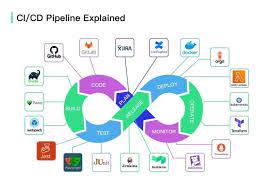
The world of software development is constantly evolving, and with this evolution comes the need for advanced practices such as Continuous Integration (CI) and Continuous Deployment (CD). These methodologies are pivotal in reducing the time between writing code and deploying it to production, thereby enhancing the software delivery process.
A comprehensive suite of tools underpins a robust CI/CD pipeline, ensuring that the flow from coding to deployment runs smoothly and reliably. For those determined to master this domain, engaging with a DevOps course can be an invaluable step on the path to proficiency.
Enhancing Skills with a DevOps Course
Engaging with a comprehensive DevOps course is an excellent strategy for those looking to deepen their understanding of CI/CD. It provides a structured learning path to harness these tools effectively and embed the best practices within your workflow.
The Learning Path and Opportunities
When you want to learn a DevOps course, you encounter a structured path that navigates through the nuanced spectrum of tools and practices. These courses are designed not just to instruct, but also to provide hands-on experience that is vital for grasping the full potential of a CI/CD pipeline.
Understanding CI/CD
CI/CD is a methodical approach that allows for frequent code changes to be automatically tested and released. Continuous Integration refers to the process of automatically integrating code changes from multiple contributors into a single software project. In contrast, Continuous Deployment is the step that ensures the updated code reaches the production environment without delay after the integration phase.
The Importance of the Right Toolset
Implementing a CI/CD pipeline requires a selection of tools that fit well with your organization’s needs. These tools play various roles, from code building to testing, from version control to monitoring. Each component is a clog in the wheel of a seamless automated software deployment machine.
Version Control Systems: GitHub and GitLab
One of the initial steps in setting up a CI/CD pipeline is to have in place a reliable version control system. Platforms like GitHub and GitLab not only allow for version control but also provide CI/CD capabilities. They enable teams to track changes, manage code merges, and trigger pipelines on code commitments.
Automated Build Tools: Jenkins and TeamCity
When it comes to automating the build process, Jenkins and TeamCity are frontrunners. These tools monitor the version control system and automatically start the build process when changes are detected. Jenkins, in particular, has a vast ecosystem of plugins, making it highly customizable for different development environments.
Configuring Automated Testing: Selenium and JUnit
After code is integrated, it needs to be rigorously tested. Tools like Selenium, which is used for automated web testing, and JUnit, known for its feature-rich framework in Java environments, ensure that every change is validated. By integrating these tools into your pipeline, you can detect issues early and save precious time and resources.
Continuous Deployment Magic: Docker and Kubernetes
For Continuous Deployment, tools like Docker and Kubernetes come to the forefront. Docker provides containerization, wrapping your software in a complete filesystem that contains everything needed to run: code, runtime, system tools, libraries, etc. On the other hand, Kubernetes automates the deployment, scaling, and management of containerized applications, ensuring that the newly developed features are smoothly rolled out to production.
Continuous Monitoring: Splunk and Datadog
The need for uninterrupted service availability is non-negotiable in today’s marketplace. Splunk and Datadog emerge as vital components for continuous monitoring, providing real-time data and alerts on system performance, which is essential for identifying and addressing any issues proactively.
Infrastructure as Code: Terraform and Ansible
Maintaining consistency across development, staging, and production environments is key to a successful CI/CD pipeline. Terraform and Ansible are tools that manage infrastructure through code, ensuring that environment configurations are versioned and consistent.
Assembling a CI/CD pipeline is no small feat, requiring the interplay of multiple specific tools and practices. Implementing such a system is fundamental for staying competitive in the fast-paced world of software release cycles.
Understanding the functionality and benefits of various CI/CD tools, and supplementing that knowledge with the experiential learning provided by a quality DevOps course, can make a substantial difference in your professional trajectory. The fusion of theoretical knowledge with practical application paves the way for becoming an adept DevOps practitioner, capable of orchestrating a pipeline that’s both efficient and robust.
Leave a Reply